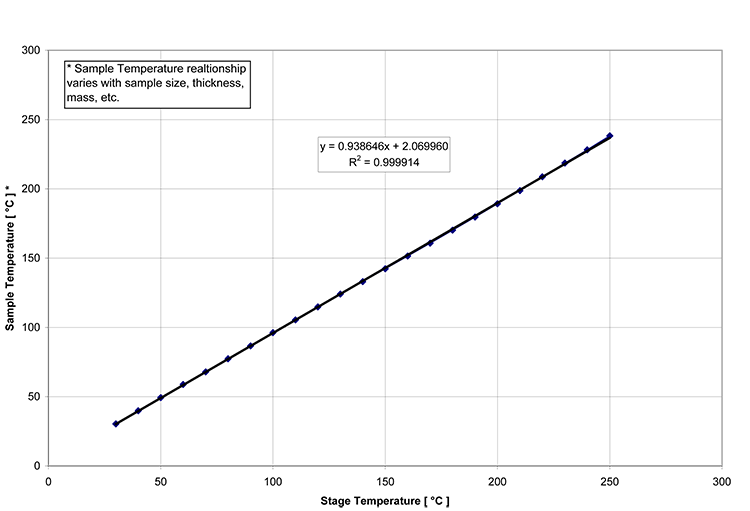
The High Temperature Heater and –35ºC to 100ºC Heater/Cooler have been extensively tested imaging polymer samples in TappingMode, but can also be applied to studies of other materials and in other modes.
Uncoated etched silicon probes work best for heating/cooling in a gas environment. Bi-metallic or coated probes may produce unwanted heat-induced bending.
Ensure that you reset the parameters to their default values (12) when using the standard air tapping or TR holder.
Thin films on a small (1/4 inch, or 6.3 mm diameter) metallic puck are most suitable for AFM studies at elevated temperature. In such cases, the sample temperature is closer to that measured by the heater thermocouple. Larger pucks and thick samples can be placed on the heater surface, but keep in mind the limited power output of the heater and the possibility of the sample temperature being less than that indicated by the heater thermocouple.

Figure 1: Sample temperature vs. stage temperature
A magnet incorporated in the heater element holds the metallic sample puck to the heater surface. Samples consisting of a film on a flat substrate (such as mica, a silicon wafer, graphite, etc) or a small block of material with a flat top surface, should be glued to the puck. Choice of glue can be significant for imaging at temperatures above 100°C. Epoxy-based glues may contain volatile components or may decompose in the heat. An exuded material condensed on the window of the heater/probe holder can reduce the window's transparency, thus disrupting the laser beam. Heating the probe prevents condensation of volatile material on the cantilever itself. Low molecular weight materials, which are often added to industrial polymers, may alter the polymer surface being imaged. For example, industrial polypropylene contains a constituent that appears as large droplets on the polymer surface at high temperatures (but below the polymer melting point).
Larger samples require that a heater/cooler cover with matching sample puck be placed on top of the Heater/Cooler element:
Figure 2: 12 mm (left) and 15 mm (right) Heater/Cooler Covers on the Heater/Cooler Element
Smear Wakefield Thermal Compound, from Wakefield Engineering (part number 120-2) on the mating surfaces (small tungsten cap and small surface under the covers) before putting the components together.
| www.bruker.com | Bruker Corporation |
| www.brukerafmprobes.com | 112 Robin Hill Rd. |
| nanoscaleworld.bruker-axs.com/nanoscaleworld/ | Santa Barbara, CA 93117 |
| Customer Support: (800) 873-9750 | |
| Copyright 2010, 2011. All Rights Reserved. |